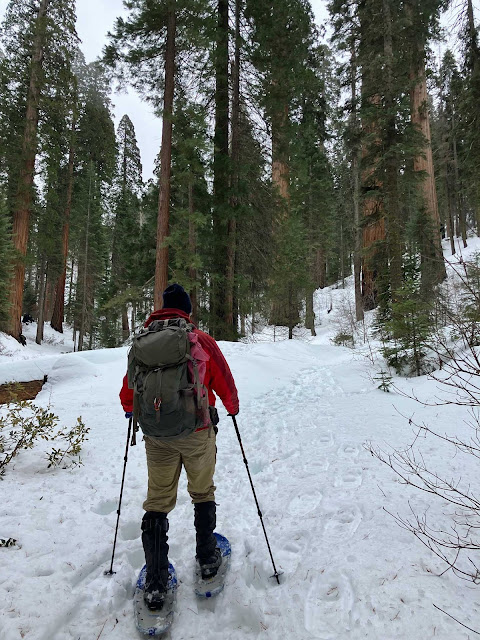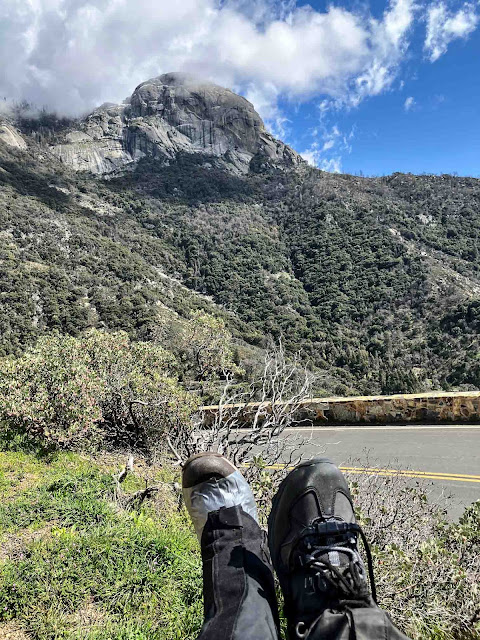This is just a draft. July 2025 Eastern Sierra
Look, Mom, We're Camping!
Our travels, mostly in our small Fun Finder trailer
Monday, September 15, 2025
Monday, July 01, 2024
Sequoias and Local Mountains: March - June 2024
Continuing my rehab, we took four quick trips: to Giant Forest in March, to the Grant Grove area in April, to Mt. Baldy in May, and to Mt. Pinos in June.
March 12: We stayed at Potwisha Campground and "commuted" to the Wolverton area, near Giant Forest. It was foggy and cold, but we didn't care -- it was great just to be on snowshoes again.
The first two miles were in gently rolling terrain. I did some homework and came up empty -- how come the high mountains in this area have relatively flat summits? It must have something to do with the movement of the San Andreas, which runs along the foot of the mountains, but I am stumped.
Wednesday, January 17, 2024
Anza Borrego Desert State Park: December 2023
December 13, 2023: After a very difficult year filled with medical issues, we finally took a little trip to Anza Borrego Desert State Park to see the Geminid meteor shower. At the beginning of 2023, it looked like our camping days were over – I could not walk.
After back surgery and rehab to deal with nerve damage to my feet, we were once again on the road, testing my ability to deal with the rigors of camping and moderate hiking. (Spoiler alert: no big problems.). We camped in Blair Valley, which has dark skies and plenty of boondocking:
(Those pictures make it look as though we were all alone. We weren't – there were a couple of other trailers scattered about a quarter-mile away.)
Felice took a short hike around the area in the late afternoon and snagged (not literally) this great backlit shot of buckhorn cholla:
The meteor shower was excellent, among the best we have ever seen. There was a little light pollution from distant towns, but not too much. We saw about 25 meteors in about 90 minutes, many of which were bright white or green with long tails. The temperature was around 40 degrees, with almost no wind. I can't say that we were warm, but this was our least uncomfortable Geminid shower, ensconced in our camp chairs, properly dressed, with a big sleeping bag draped over our laps.
December 14: We took the Borrego Palm Canyon trail, which starts in Borrego Springs. Unlike last time, we didn't see any mountain sheep, but the weather was cool and clear.
The boulders lining the floodplain were impressive – imagine the volume of water that tumbled these rocks! To get a sense of scale, Felice is at center right:
More evidence of tremendous flooding – the ends of this massive chunk of palm trunk were rubbed round, like a well-used pencil eraser, after being worn down by many storms:
That huge black boulder deserves a paragraph or two. (If you're not fascinated by rocks, skip this stuff.). Note the color and texture – this is dark fine-grained volcanic rock, almost like obsidian but probably basalt, with veins of quartz, much harder than the coarse-grained surrounding "country rock" of beige granite. How did it get here? Did the granite overlay the older basalt (unlikely) or did the newer lava punch through the granite?
Without scouting far upstream for the original basalt outcropping, there's no way to tell if the basalt predated the granite. But it is clear that this anomalous boulder fell into the canyon and was then tumbled and rounded by thousands of "thousand year" floods. (End of geology moment.)
We came across a "mortero," a cup-like depression in the rock where the native folks used to grind seeds. I am told that the term "Indian" is no longer used:
I am also told that the hard work of grinding the seeds was given to the women, who would sing to keep the rhythm. There are Navajo corn grinding songs available on YouTube – I would guess that the Borrego Springs tribe's songs were similar, but there is no way to know.
After a leisurely climb, we arrived at the palm oasis, complete with a miniature waterfall (about a foot high):
Amazingly, there were little frogs in the pool at the foot of the falls. How did they brave the surrounding desert to arrive at this pool? Tadpoles are notoriously bad hikers. These frogs must be remnants of the ice ages, when the streams ran down into inland seas, providing a way for the frogs to populate the canyons. Now they are stranded on a wet island in the desert. (We didn't get a photo of the frogs, who were unremarkable.)
That evening, as we approached the campsite just after sundown, the almost-new crescent moon was colored by "earthshine," which is exactly what it sounds like: the light of the sun reflects off the earth and illuminates the dark part of the moon. Unfortunately, neither Felice's iPhone nor my old DSLR could quite capture this phenomenon, due to the high contrast between the dark side of the moon and the sliver of "daylight." This is the iPhone shot:
And this is the DSLR shot, with the telephoto zoom:
December 15: The drive home took only four hours. Although the desert is not our top choice for camping and hiking, this little trip was a big success because it proved that we are ready to get back on the road.


















































